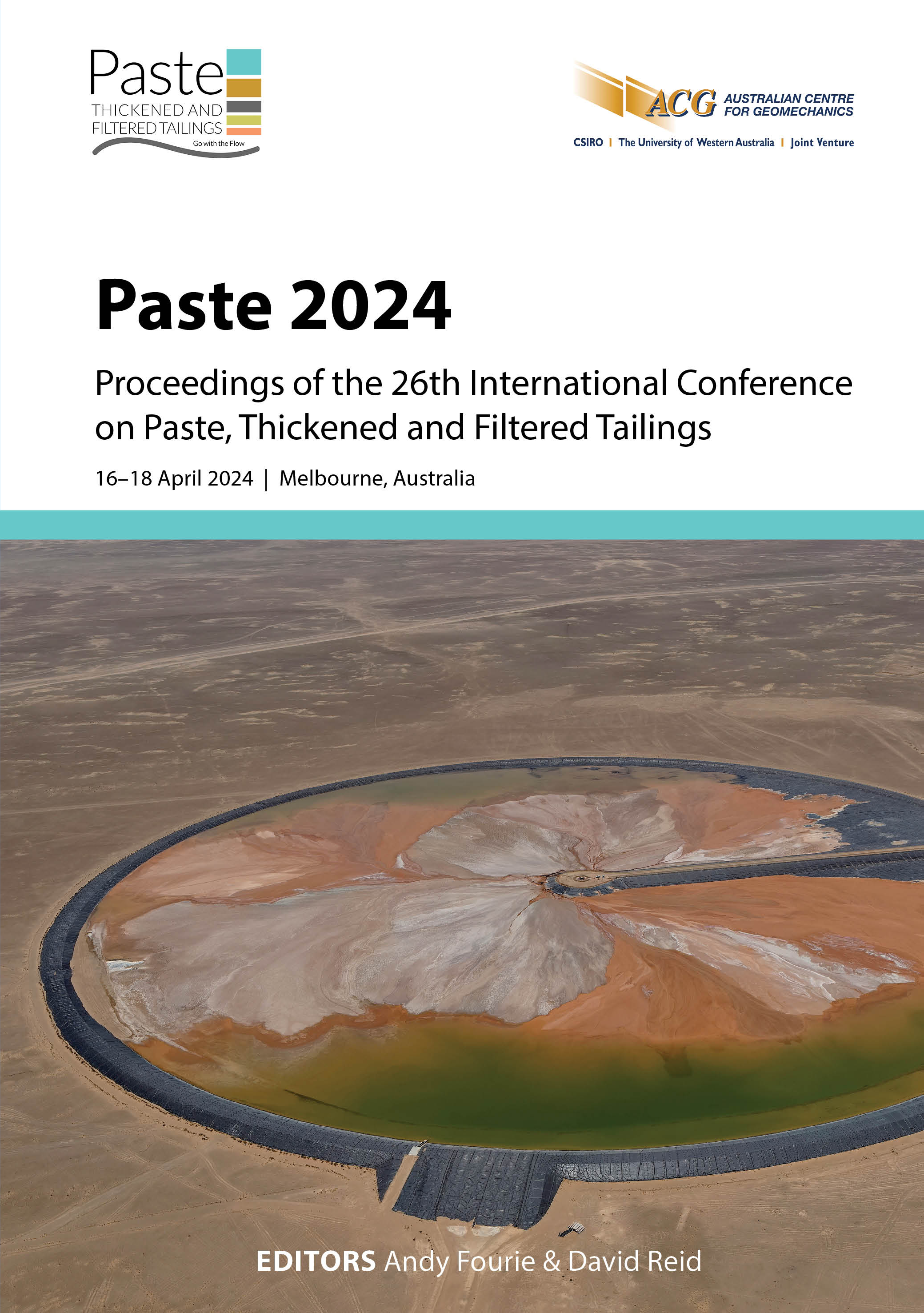Critical pathways for selecting paste backfill process for Rio Tinto Kennecott mine

|
Authors: Pavlovic, N; Timbillah, S; Roberge, JL; Moran, K; Sliede, B; Hutton-Ashkenny, M |
DOI https://doi.org/10.36487/ACG_repo/2455_04
Cite As:
Pavlovic, N, Timbillah, S, Roberge, JL, Moran, K, Sliede, B & Hutton-Ashkenny, M 2024, 'Critical pathways for selecting paste backfill process for Rio Tinto Kennecott mine', in AB Fourie & D Reid (eds), Paste 2024: Proceedings of the 26th International Conference on Paste, Thickened and Filtered Tailings, Australian Centre for Geomechanics, Perth, pp. 65-76, https://doi.org/10.36487/ACG_repo/2455_04
Abstract:
Rio Tinto Kennecott’s Integrated Skarn Project is completing a feasibility level of design for the future underground mine that consists of a number of ore zones: Low Commercial Skarn, North Rim Skarn (NRS), Middle Block, Fortuna, NRS – Extension, and Carr Fork. The ore zones are located under the northern wall of the existing open pit, Bingham Canyon Mine. The underground mine will contribute a relatively small fraction of the overall ore stream with the bulk coming from the open pit. The ore will be processed at the existing Copperton Concentrator. Responsible Mining Solutions was retained by Rio Tinto to complete a feasibility level study for paste backfill and to complete the testing campaign to support the broader study. Concurrently, the testing campaign supported the paste backfill process design and paste backfill recipe development to meet the required backfill strengths. The tailings required for the paste backfill would be sourced from the final tailings sump and would be processed at the Copperton Concentrator area. The feasibility design has the tailings transported through an 8 km long pipeline to the paste backfill plant located at 6190 area of Bingham Canyon Mine. There were a few challenges that were encountered within the final tailings stream such as fluctuation within particle size distribution associated with large particle sizes (i.e. > 12 mm) and concentration by weight (Cw) fluctuations. These identified characteristics affected the paste backfill process design. To mitigate observed challenges, a vibrating screen with 4 mm square openings will be installed at the process onset, to protect downstream equipment and to facilitate process dewatering. Also, it was observed that the final tailings stream can contain more than 35% passing 20 µm class, which can affect process dewatering (thickening and filtration) and binder consumption. To mitigate this effect, a radial hydrocyclone cluster will be employed to produce the cyclone underflow stream with 20% passing 20 µm, to improve dewatering performances, reduce binder consumption and to maintain critical paste properties such as rheology. To reduce the paste backfill plant footprint at the 6190 area and to improve water management (quality and quantity), a single high compression thickener was selected. The thickener is planned for installation at the Coppertone Concentrator tailings area to recycle the water and to produce non-segregating thickened tailings at Cw of about 65% and concentration by volume (Cv) of 40%. The thickened tailings as such call for a 200 mm (8 inch) pipe diameter and will be transported over the 8 km long pipeline with less power consumption due to lower volumetric flowrates. This scenario also mitigates the risk of material settling along the tailings pipeline. Additionally, the overall approach requires two operating vacuum disc filters and a single standby disc filter, which reduces the paste backfill plant footprint area. This paper outlines the key design characteristics, the approach and the solution for selection paste backfill process design for Rio Tinto Kennecott underground mine.
Keywords: Rio Tinto Kennecott, skarns, paste, backfill
References:
Graham, LJW, Pullum, L, Chryss, A & Rudman, M 2001, ‘Transition to turbulence in non–Newtonian pipe flow’, 6th World Congress of Chemical Engineering, Melbourne, pp. 23–27.
Pavlovic, N, Roberge, JL & Martin, T 2019, Engineering Report for Backfill System H359812-2100-200-230-0001, Hatch (Canada) Ltd., Toronto.
Slatter, PT 2005, ‘Tailings Transport – Back to Basics!’, in R Jewell & S Barrera (eds), Paste 2005: Proceedings of the International Seminar on Paste and Thickened Tailings, Australian Centre for Geomechanics, Perth, pp. 165–176,
10.36487/ACG_repo/563_10
Stadler, G & Lee, C 2022, Integrated Skarn Project: Shotcrete and Backfill Prefeasibility B: Design Report 19129638-RPT-402-REVA, report for RMS.
Wilson, KC & Thomas, AD 2006, ‘Analytic model of laminar-turbulent transition for Bingham plastics’, Canadian Journal of Chemical Engineering, vol. 84, no. 5, pp. 520–526.
© Copyright 2025, Australian Centre for Geomechanics (ACG), The University of Western Australia. All rights reserved.
View copyright/legal information
Please direct any queries or error reports to repository-acg@uwa.edu.au
View copyright/legal information
Please direct any queries or error reports to repository-acg@uwa.edu.au
